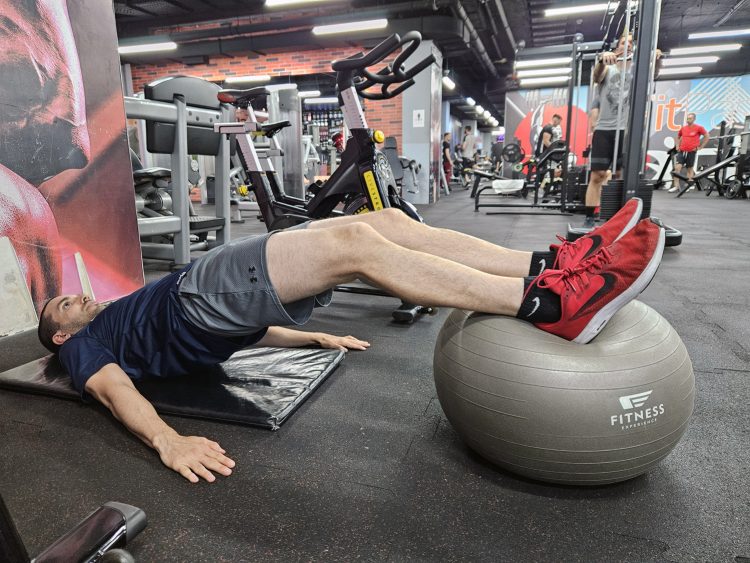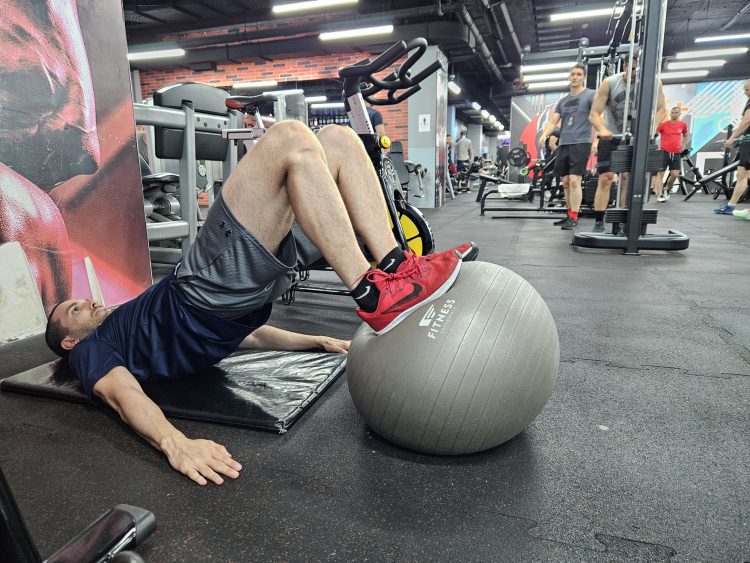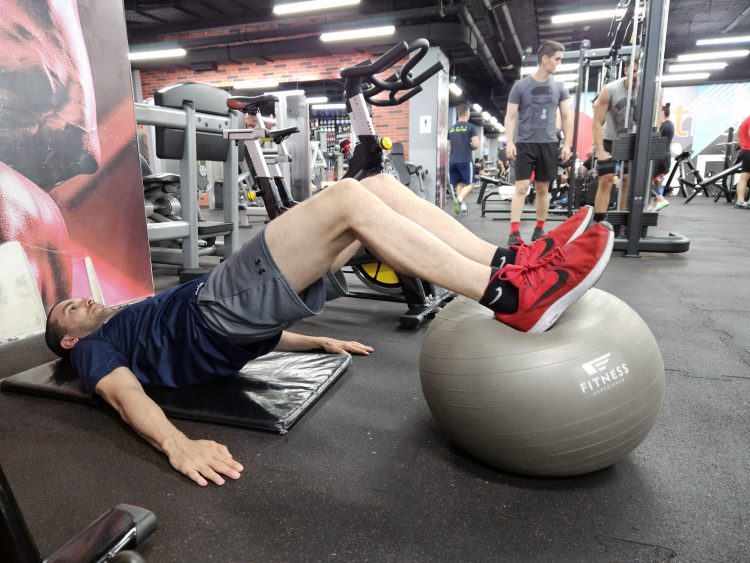Throughout my career as a personal trainer, I’ve noticed a common tendency for fitness enthusiasts and athletes to overlook their hamstrings in favor of their quads.
The cross-sectional study published in the International Journal of Sports Physiology and Performance journal showed that there is often a discrepancy in hamstring and quadriceps strength capacity, leading to an increased risk of hamstring muscle strain injuries. (1)
It’s not just the hamstrings that get overlooked; the entire posterior chain, crucial for health and performance, often doesn’t receive the attention it deserves.
I like stability ball leg curls because they are versatile and effective for simultaneously targeting multiple posterior chain muscles.
Let me tell you how to perform it and what the benefits and alternatives are.
How To Do Stability Ball Leg Curl
Here’s a step-by-step guide on how to perform this exercise with proper form:
Level Up Your Fitness: Join our 💪 strong community in Fitness Volt Newsletter. Get daily inspiration, expert-backed workouts, nutrition tips, the latest in strength sports, and the support you need to reach your goals. Subscribe for free!
Step One — Set-Up
Position a stability ball on the floor. Lie supine on the floor with your knees bent, back flat, and arms next to your body.
Put your heels on the stability ball and lift your hips off the ground. Keep your body aligned straight from shoulders to heels once you get to the position.
Pro Tip: Experiment with the stability ball’s placement to determine the most comfortable and effective option.
Step Two — Initiate the Movement
Bend your knees to draw the stability ball towards your hips. Actively press your heels into the ball to bias the hamstrings.
Pro Tip: Avoid two more common mistakes — overarching the back and letting the hips sag.
Step Three — Lowering Phase
Extend your legs to roll the ball away from your body and get into the starting position. Visualize your hamstrings lengthening as you extend your knees to feel a deep hamstring stretch and improve the mind-muscle connection. (2)
Perform 10 to 15 reps, depending on your goals and fitness level.
Pro Tip: This exercise should be performed slowly and with complete control. Time under tension and excluding momentum are very important steps.
Watch Filip Maric perform the exercise below:
Level Up Your Fitness: Join our 💪 strong community in Fitness Volt Newsletter. Get daily inspiration, expert-backed workouts, nutrition tips, the latest in strength sports, and the support you need to reach your goals. Subscribe for free!
Muscles Worked
Here are the muscles trained in this exercise:
- Hamstrings: The hamstrings flex the knees and extend the hips. Those movements are responsible for walking, running, and jumping. During the stability ball leg curl, the hamstrings contract eccentrically and concentrically, which I find particularly useful. Concentric contraction occurs during the first part of the exercise, while the hamstrings contract eccentrically during the lowering phase.
- Glutes: Despite the emphasis on the hamstrings, the gluteal muscles’ involvement is significant. Lifting your hips activates the glutes, including the gluteus maximus, medius, and minimus, stabilizing the hips and maintaining body stability.
- Core: During the exercise, the rectus abdominis, obliques, and transverse abdominis function together to stabilize the spine and pelvis. The quadratus lumborum (QL) and other lower back muscles also play a role alongside the core.
Benefits of Stability Ball Leg Curl
What will you get from doing the stability ball leg curl regularly? Let’s find out:
Strengthening Hamstrings
Hamstrings are part of the posterior chain. They are a group of three muscles: the biceps femoris, semitendinosus, and semimembranosus.
The stability ball leg curl is one of the prime exercises for targeting these muscles. Stronger hamstrings directly translate into better athletic performance and posture. Over time, you will notice how you run faster and change direction more efficiently.
Enhancing Balance and Coordination
I’m not a fan of practicing sport-specific movements on an unstable surface, but the instability of the stability ball can certainly improve your proprioception and body awareness. Your body must become accustomed to the unstable nature of the stability ball.
Injury Prevention
Strengthening the muscles around the knee joint is crucial for reducing the risk of knee injuries, such as strains and sprains. Did you know that weak hamstrings increase the risk of an ACL tear, one of the most severe injuries? (3)(4) So, making your hammies strong is one of the ways to bulletproof your knees.
Increased Range of Motion
This exercise encourages flexibility and range of motion in the hip and knee joints. You actively stretch and contract the muscles surrounding these joints as you move through the exercise. It improves flexibility and mobility, both necessary for good ROM.
Dr. JP Gloria, a physical therapist and performance coach for runners, explained the hamstrings’ importance during both push-off and deceleration:
“There are multiple muscles involved during push-off, one of these being the hamstrings. As you push off the ground, the hamstring contracts and helps extend the hips for improved force production. But that’s not all. Another important role of hamstrings is to decelerate knee extension as the foot swings forward. This is important because if this does not occur, the leg would end up landing way in front of the body, which would cause over-striding. If the foot lands this way, not only would it put more strain on the knee, but it’ll also take much longer to transition to push-off. This would hamper your speed.”
Alternatives to Stability Ball Leg Curl
Here are three alternatives that, depending on your fitness level and accessible equipment, you can incorporate into your hamstring training regime.
Resistance Band Leg Curl
I really like this exercise for three reasons. First, it is suitable for all fitness levels. Second, using a resistance band adds variable resistance to the movement. Third, it can be performed virtually anywhere, so you can work your hammies and glutes even at home.
How To:
- Attach one end of a resistance band to a stable anchor point.
- Loop the other end of the resistance band around one or both ankles.
- Lie face down on the floor with your legs extended.
- Engage your core and glute muscles to stabilize your body, then bend your knees and curl your heels towards your buttocks, pulling against the band’s resistance.
- Pause at the top of the movement.
- Slowly lower your legs back to the starting position.
Pro Tip: Don’t let the resistance band lose tension in any part of the movement. If that happens, change the position.
Slider Leg Curl
When I work with professional athletes, I always include the slider leg curl in the workout routine. Few exercises match the strength and coordination required for field movement and sprinting like this one. It’s an ideal dynamic lower-body exercise, focusing on the hamstrings and glutes, minimizing injury potential from typical causes. (5)
However, be cautious, as inadequate strength or skipping warm-ups can lead to hamstring strains.
How To:
- Lie on your back with your heels on sliders and your arms by your sides.
- Lift your hips off the ground to form a straight line from your shoulders to your knees.
- Slide your heels away from your body (in the beginning, slower, as you progress faster), extending your legs until your body is almost in a straight line.
- Squeeze your hamstrings to bend your knees and slide your heels back towards your body.
Pro Tip: Once you master bilateral slider leg curl, try the single-leg variation.
Machine Leg Curl
The machine leg curl is a good choice if you are in the gym and want to target your hamstrings.
This exercise provides controlled and isolated movement, making it safe for everyone. Depending on the type of machine your gym has, you can do it either seated or lying.
How To:
- Adjust the machine according to your height.
- Lie face down on the machine with your knees slightly bent and your ankles under the pad.
- Grasp the handles and brace your core.
- Exhale as you flex your knees and curl the pad towards your buttocks.
- Hold the peak contraction, then inhale as you slowly lower the pad back to the starting position.
Pro Tip: Use slow and controlled reps to ensure the hamstrings are doing most of the work.
Wrapping Up
The stability ball leg curl is an efficient exercise for strengthening the hamstrings and glutes and enhancing overall balance and coordination. Pay attention to your form and avoid common mistakes that reduce effectiveness and increase the chance of injury.
If you have any questions about stability ball leg curl, hamstrings, or sprint improvement in general, leave a comment below, and I’ll be more than happy to help!
References
- Ishøi L, Krommes K, Nielsen MF, Thornton KB, Hölmich P, Aagaard P, Penalver JJJ, Thorborg K. Hamstring and Quadriceps Muscle Strength in Youth to Senior Elite Soccer: A Cross-Sectional Study Including 125 Players. Int J Sports Physiol Perform. 2021 Oct 1;16(10):1538-1544. doi: 10.1123/ijspp.2020-0713. Epub 2021 Apr 22. PMID: 33887700.
- Calatayud J, Vinstrup J, Jakobsen MD, Sundstrup E, Brandt M, Jay K, Colado JC, Andersen LL. Importance of mind-muscle connection during progressive resistance training. Eur J Appl Physiol. 2016 Mar;116(3):527-33. doi: 10.1007/s00421-015-3305-7. Epub 2015 Dec 23. PMID: 26700744.
- Myer GD, Ford KR, Barber Foss KD, Liu C, Nick TG, Hewett TE. The relationship of hamstrings and quadriceps strength to anterior cruciate ligament injury in female athletes. Clin J Sport Med. 2009 Jan;19(1):3-8. doi: 10.1097/JSM.0b013e318190bddb. PMID: 19124976; PMCID: PMC9928500.
- Weinhandl JT, Earl-Boehm JE, Ebersole KT, Huddleston WE, Armstrong BS, O’Connor KM. Reduced hamstring strength increases anterior cruciate ligament loading during anticipated sidestep cutting. Clin Biomech (Bristol, Avon). 2014 Aug;29(7):752-9. doi: 10.1016/j.clinbiomech.2014.05.013. Epub 2014 Jun 11. PMID: 24970112.
- Danielsson A, Horvath A, Senorski C, Alentorn-Geli E, Garrett WE, Cugat R, Samuelsson K, Hamrin Senorski E. The mechanism of hamstring injuries – a systematic review. BMC Musculoskelet Disord. 2020 Sep 29;21(1):641. doi: 10.1186/s12891-020-03658-8. PMID: 32993700; PMCID: PMC7526261.
Interested in measuring your progress? Check out our strength standards for Lying Leg Curl, Seated Leg Curl.











